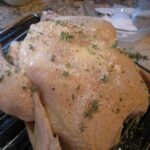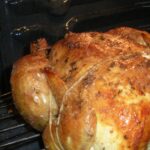SIMPLE ROAST CHICKEN
For dinner tonight I made a simple roast chicken. Roasting a chicken is not as simple as it appears. The trick is achieving a golden crispy exterior and a thoroughly cooked interior with both white and dark meat retaining their juices. At one time or another we’ve all begun carving the bird, only to discover to our chagrin that the white meat is overcooked or the dark meat is undercooked!
I have found that using the convection roast setting on my oven at 425 degrees produces the desired crispy on the outside yet juicy on the inside result I’ve been looking for. The fan allows the heat to circulate which results in accelerated cooking time and a more even heat.
This acceleration effect is one reason for the superior results you get from convection cooking. The rush of heat speeds up the chemical reactions that occur when food cooks. The butter in a pie crust or a croissant releases its steam quickly, creating flaky layers. The skin of a roasting chicken renders its fat and browns more quickly, so the meat cooks faster and stays juicier. The sugars in roasting vegetables and potatoes begin caramelizing sooner, creating crisp edges, moist interiors, and deep flavors. Overall, food cooked in a convection oven is usually done about 25% faster than it is in a conventional oven.
Although I am espousing the merits of convection cooking, I don’t mean to convey that one cannot make a delicious roast chicken in a conventional oven. Until 3 years ago, and a kitchen remodel that included my long awaited double ovens, I used a conventional oven with no bells or whistles. And I used it well…and often. In fact, as I watched it go down my street in the back of an open truck that was hauling it away I had tears in my eyes thinking of all the meals I prepared on that stove for the previous 20 years. It served me well, to say the least. But enough about my overly emotional and sentimental side… I found some interesting facts online about roasting the perfect chicken, regardless of your oven type, and thought they might be helpful…
Size matters. Position doesn’t. That’s what a palate-weary Sunset panel decided after blind-tasting more than 50 chickens. The objective: to settle the argument about the best way to roast a bird.
The panel came to other critical conclusions as well: What’s the ideal oven temperature to produce a chicken that is beautifully browned and crisp and still yields succulent breast and thigh meat? Is the breast really juicier if roasted downward–even part of the time? Does rubbing the chicken with fat before roasting achieve anything? Is the skin more or less crisp when basted? And–perhaps the most controversial question of all-are free-range, organic chickens any more flavorful than their standard commercially reared cousins?
Oven temperature. A constant 425[degrees] oven–regular or convection–produced the crispest, most richly browned skin and juiciest breast and thigh meat. (At 500[degrees], the chicken browned well, but it also spewed a prodigious amount of fat and smoke–more than you may want in your kitchen.) Starting at a very high temperature, then lowering it, also yielded brown, crisp skin, but the minimal difference doesn’t warrant the step.
* Chicken position. Starting the bird breast down, then turning it over to brown, didn’t keep the meat any moister. Nor did rotating the chicken from side to side. And in both cases, the skin wasn’t as nicely colored.
* Rubbing with fat. Smearing the bird with butter or oil before roasting made the skin slightly crisper but had no flavor impact.
* Basting. Spooning the pan drippings over the chicken as it roasted made the skin less crisp and, again, added nothing to the meat flavor.
* Free or not. In the most telling taste tests of all, standard commercially reared chickens edged out free-range birds for best flavor. So let your environmental convictions be your guide. The bottom line: Proper roasting makes any bird delectable.
* Size. Big chickens–often labeled roasters (generally 6 to 8 lb., occasionally up to 10 lb., but less than 12 weeks old)–have deeper, richer, and more complex flavor than smaller ones. Of course, young chickens (also called broilers and fryers; under 6 lb. and about seven weeks old) can be roasted. But by the time the skin is an appealing color, the breast meat of smaller birds is cooked past its prime. A roaster, however, reaches perfection inside and out at the same time.
In fact, everything a roast chicken does well, it does best when bigger. It makes a more dramatic presentation, it accommodates more people, and it provides leftovers for sandwiches, soups, salads, pastas, or just plain nibbles.
Here’s my recipe for a Simple Roast Chicken
Preheat oven to 425 degrees. (Use the convection roast setting if you have it)
Rinse and dry with paper towels a 6 pound roaster, including the cavity. Remove the neck, liver, and giblets and freeze for a future use if you like. Necks are great for chicken stock.
Brush melted butter over the entire chicken. If you prefer you can brush with olive oil. Season liberally with kosher salt and freshly ground black pepper, inside and outside, and sprinkle with some fresh thyme. Stuff the cavity with a whole lemon, cut in half, a few sprigs of fresh thyme and fresh rosemary.
Truss chicken with butcher’s twine, and place on rack in shallow baking pan. Roast for approximately 1 and ¼ hours. Times will vary depending on the oven.
Remove from oven when done and allow to rest, covered loosely with foil for 20 minutes. This will enable the juices to come back to the surface. Serve the remaining pan juices, skimmed of fat, along with the chicken.

